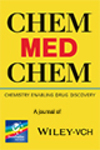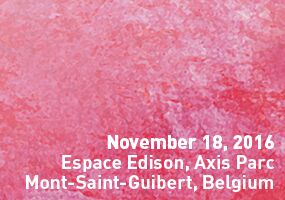MedChem 2016 is an EFMC Sponsored Event

|
Confirmed Speakers
PL03 - Clinical Imaging Agents, and the Art of Medicinal Chemistry
 | Dr Yves P. AUBERSON
(NOVARTIS INSTITUTES FOR BIOMEDICAL RESEARCH, Basel, Switzerland)
Read more
Dr. Yves P. Auberson is Executive Director in Global Discovery Chemistry at the Novartis Institute for BioMedical Research in Basel, Switzerland.
He currently leads PRIMA, a group developing tracers for clinical PET imaging. Previously, he served as Head of Chemistry for Neuroscience, and played a leading role in the discovery and development of drug candidates for the treatment of epilepsy, Alzheimer’s disease and narcolepsy.
He also acts as President of the Division of Medicinal Chemistry and Chemical Biology of the Swiss Chemical Society, and is a member of the Executive Committee of the European Federation of Medicinal Chemistry.
He obtained his Ph.D. in 1990 with Prof. Pierre Vogel at the Swiss Federal Institute of Technology in Lausanne, Switzerland. He joined CIBA (now Novartis), after a post-doctoral training with Prof. Peter Schultz at Affymax in Palo Alto, USA. Close window |
PL01 - PET Tracer Development and Translation to the Clinic
 | Prof Guy BORMANS
(KULEUVEN, Leuven, Belgium)
Read more
Guy Bormans graduated as a pharmacist at the KU Leuven in 1986. He obtained his PhD in 1990 at the Lab of Radiopharmacy KU Leuven in Belgium based on research with technetium-99m labeled compounds for visualization of kidney function. Subsequently he did a postdoc in PET radiochemistry in the University of Michigan USA and returned to the the KU Leuven to build out research with PET radiopharmaceuticals labeled with fluorine-18 and carbon-11. Guy Bormans is currently the head of the laboratory of Radiopharmacy at the KU Leuven and has co-authored more than 200 peer reviewed publications.
His area of research covers radiosynthesis, QC and in vitro and in vivo evaluation and validation of PET radiopharmaceuticals. Besides academic research he has several projects in cooperation with pharmaceutical industry where PET radiopharmaceuticals are applied for CNS drug development.
Close window |
PL02 - PET Chemistry: Routine Application, Recent Advances and Ongoing Challenges
 | Dr Jan PASSCHIER
(IMANOVA, London, United Kingdom)
Read more
Jan Passchier completed his MSc in Organic Chemistry and his PhD in Medicinal Sciences at Groningen University in the Netherlands. In September of 2000, he joined GlaxoSmithKline (GSK) in Cambridge (UK) as a PET radiochemist. In this capacity, he was responsible for many PET ligand development and candidate labeling activities across the drug development portfolio. While at GSK, he was part of the design team for the GlaxoSmithKline Clinical Imaging Centre, now Imanova Ltd, where he currently serves as director of operations and head of preclinical sciences. Jan has served as subject matter expert for the EFPIA and holds honorary positions as Senior Lecturer in the department of medicine at Imperial College London and with the Leonard Wolfson Experimental Neurology Centre at University College London.
Close window |
PL05 - Antibody Imaging and Therapy Using in Vivo Click and Click-to-Release Strategies
 | Dr Marc ROBILLARD
(TAGWORKS PHARMACEUTICALS, Eindhoven, The Netherlands)
Read more
Marc Robillard is founder and CEO of Tagworks Pharmaceuticals, a spin-out of Philips. Tagworks develops and applies bioorthogonal conjugation and elimination chemistry in living systems to improve the efficacy of cancer therapies and to enable novel approaches in companion diagnostics. Prior to spinning out in 2011 he worked at Philips Research on molecular imaging and drug delivery and at Kreatech Diagnostics on microarray detection. Marc obtained his MSc and PhD in bio(in)organic chemistry at, respectively, the University of Groningen and the Leiden Institute of Chemistry, The Netherlands. Close window |
PL04 - SV2A Imaging and the Potential Applications in Neurodegenerative Disorders
 | Prof. Eric SALMON
(ULG, Belgium)
Read more
SALMON Eric, Pol, MD (University Liège 1983); Research Fellow, MRC Cyclotron Unit, Hammersmith Hospital, and Honorary Research Fellow, RPMS (London, 1987-1988); Specialist in Neurology (University of Liège, 1988), PhD in biomedical sciences (University of Liège, 1991, Specialist in Nuclear Medicine (University of Liège, 1994). Professor, Neuroimagery of Memory and Cognitive Readaptation, University of Liege. Medical Director, Cyclotron Research Centre, University of Liege. Medical Responsible Memory Clinic and Memory Centre, Service of Neurology, CHU Liege. Research domains: Behavioural Neurology, dementia, Alzheimer, neuroimaging, cognitive rehabilitation (http://www.cyclotron.ulg.ac.be). Publications: http://orbi.ulg.ac.be/. Email: eric.salmon@ulg.ac.be Close window |
PL06 - The Value of PET Ligand Discovery to CNS Drug Development
 | Dr Mark SCHMIDT
(JANSSEN PHARMACEUTICA, Beerse, Belgium)
Read more
Dr. Schmidt is a Senior Director in Experimental Medicine for Janssen Pharmaceutica, N.V. in Beerse, Belgium. He received his medical degree from the University of Chicago in 1983 and entered postgraduate training in psychiatry and clinical service in the US Navy. Following Naval service, Dr. Schmidt was a research fellow in the National Institute of Mental Health (NIMH) intramural program where he focused on the use of functional imaging as a pharmacodynamic marker. Following fellowship, he worked at Lilly Research Laboratories, Novartis, and now Janssen. He has been responsible for clinical testing of NMEs for psychiatric indications through proof of concept and has led a preclinical imaging group for development of site specific PET tracers and then qualifying them in human. He has authored over 50 peer-reviewed manuscripts, reviews, and book chapters on the use of in vivo imaging for CNS drug development. Close window |
Selected Oral Communications
OC02 - Synthesis and in vivo PET Evaluation of a 18F Bile Acid to Assess Drug-Induced Liver Injury in Mice
 | Mr Stef DE LOMBAERDE
(GHENT UNIVERSITY, Gent, Belgium)
Read more
Stef De Lombaerde graduated as a pharmacist from Ghent University in 2014.
Since then, he works there as PhD-student at the Laboratory for Radiopharmacy of prof.dr. Filip De Vos. His research is focused on the development of fluorine-18 labeled bile acids to study drug-induced liver injury and liver diseases.
Close window |
OC03 - in vivo Evaluation of Novel 18F-Labeled TCO Analogues for Pretargeted Immuno-PET Imaging in a HER2 Positive Cancer Model
 | Mr Jens FISSERS
(UNIVERSITY OF ANTWERP, Antwerpen, Belgium)
Read more
Jens Fissers got his degree as a pharmacist in 2012 at the University of Antwerp. Thereafter he immediately continued his degree at university of Antwerp as a PhD student at the laboratory of Medicinal chemistry run by Koen Augustyns. The topic of his thesis is about Immuno-PET and bioorthogonal chemistry for non-invasive imaging of xenograft and transgenic mouse models.
Close window |
OC01 - Late-Stage Fluorination for PET Imaging
 | Prof. Tobias RITTER
(MAX-PLANCK-INSTITUT FÜR KOHLENFORSCHUNG, Mulheim, Germany)
Read more
Tobias Ritter received his undergraduate education in Braunschweig, Germany, Bordeaux, France, Lausanne, Switzerland, and Stanford, US. He has performed undergraduate research with Prof. Barry M. Trost at Stanford, obtained his PhD working with Prof. Erick M. Carreira at ETH Zurich in 2004, and was a postdoc with Prof. Robert H. Grubbs at Caltech. In 2006, Tobias was appointed as Assistant Professor in the Department of Chemistry and Chemical Biology at Harvard, promoted to Associate Professor in 2010, and to Professor of Chemistry and Chemical Biology in 2012. Since 2015 he is director at the Max-Planck-Institut fuer Kohlenforschung in Germany and holds additional faculty appointments at Harvard and Massachusetts General Hospital. The Ritter lab focuses on late-stage fluorination chemistry and catalysis for functionalization of complex small molecules. In 2011, Tobias founded SciFluor LifeScience, a pharmaceutical development company. Close window |
|
Organised by


With the support of

Sponsors



Media Partners



|




















